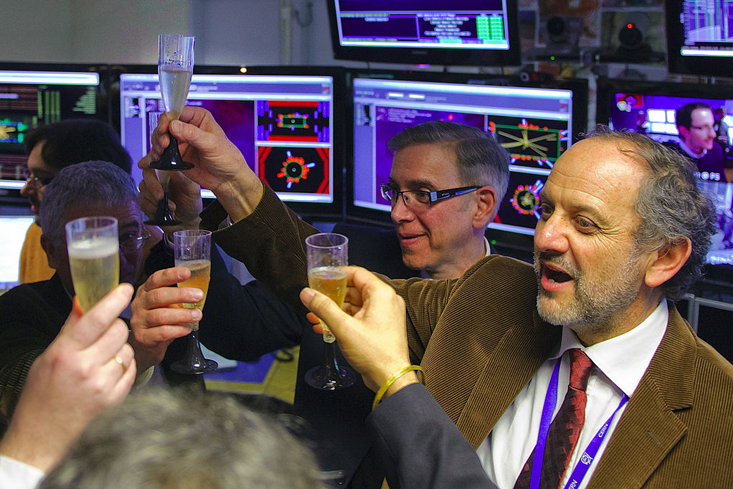How do scientists decide what research to do? One would like to think that they take a suitably scientific approach to this question by thinking about important problems that need to be solved, and asking which of these problems could be solved given the time and money available. But are research projects actually proposed and funded in this way, or are there other forces at work?
Particle physicists and astronomers realized decades ago that they needed to take a coordinated approach to planning so that they had accelerators and telescopes to work on. This “big science” approach involved agreeing on the long-term scientific goals in a given field and then getting the relevant funding agencies in different countries on board. This approach has been remarkably successful, as demonstrated by the recent detections of the Higgs boson and gravitational waves. But it does not always go to plan—if it did, a chemical company called Magnablend would not own the site of the abandoned Superconducting Super Collider in Texas.
But what happens in other areas of research, that tend to be organized from the bottom up rather than from the top down?

In late 2014 four prominent life scientists in the United States published a provocative essay titled “Rescuing U.S. biomedical research from its systemic flaws.”1 The essay described how two long-term trends—an ongoing increase in the number of biomedical researchers in the U.S. and an ongoing decrease in real-terms funding for the National Institutes of Health (NIH)—were leading to “hypercompetition” for grants and jobs. This, the authors argued, was “suppress[ing] the creativity, cooperation, risk-taking, and original thinking required to make fundamental discoveries.”
Some of the solutions proposed in the essay, such as reducing the number of Ph.D. students in the biomedical sciences, proved unpopular, but few disagreed with the conclusion that “the low success rates [for NIH grant applications] have induced conservative, short-term thinking in applicants, reviewers, and funders. The system now favors those who can guarantee results rather than those with potentially path-breaking ideas that, by definition, cannot promise success.”
Funding agencies are aware of this problem. “Most scientists don’t want to be conservative in their work,” says Jon Lorsch, director of the National Institute for General Medical Sciences (NIGMS), which is part of the NIH. “Unfortunately, when funding is tight the system has a tendency to force investigators and grant reviewers to be more conservative. The constant worry that you are going to lose your funding has a serious dampening effect on an investigator’s willingness to start risky or ambitious research.”
One alarming manifestation of the problems brought about by hypercompetition is that there are now more NIH-funded principal investigators over 65 than there are under 35. This is unlikely to make the field less conservative in the near future.
Studies of the research literature back up the claim that biomedical research is becoming more conservative. Andrey Rzhetsky of the University of Chicago and three co-workers—Jacob Foster, Ian Foster, and James Evans—recently used natural-language processing to analyze more than 2 million research papers and almost 300,000 patents involving research on more than 30,000 molecules in biomedicine over the past 30 years.2
The study found that most researchers focused on molecules that were known to be important and that they mostly explored molecules that were closely related to each other. Moreover, the choices made by the researchers became more conservative over time. However, researchers who had enjoyed success in their careers (such as winning prizes for their work) were more likely to have employed less conservative approaches, such as trying to establish connections between molecules that were not closely related.
There are now more NIH-funded principal investigators over 65 than there are under 35.
This conservatism and inertia has a serious downside: One might think that governments and funding agencies can exert some degree of influence over what science gets done by, for instance, targeting particular diseases, but that is not the case. For example, research by Lixia Yao of the University of North Carolina at Charlotte and co-workers—Ying Li, Soumitra Ghosh, Evans, and Rzhetsky—has found that the allocation of biomedical resources in the U.S. is influenced by previous allocations and research “far more” than it is influenced by current health needs.3 The most “over studied” conditions in 2011 included several forms of cancer, renal failure, various heart conditions, and some respiratory problems. And in a separate analysis of the impact of 111 medical conditions in different countries around the world, Evans and other co-workers found that medical conditions that are common in the developed world received more attention from researchers than diseases that are disproportionately found in the developing world.4

Are there other, more fundamental reasons, besides funding pressures, that might explain the conservatism seen in the biomedical sciences? The suspicion with which many life scientists view theory and mathematical models could be part of the problem. Unlike in physics, where theory and experiment are equal partners and conservatism seems less evident, theoretical work has a very low profile in the life sciences. This is surprising given that the biggest idea in biology—evolution by natural selection—began life as a theory.
Bill Bialek is a theoretical physicist at Princeton University and the City University of New York who works on problems at the interface of physics and biology. In an eloquent essay published on the arXiv preprint server last December he described a long list of examples where theory had made crucial contributions to biology in the past, and discussed current problems that would benefit from theoretical input.5
Theoretical physicists’ imaginations are free to run riot in a way that must seem alien to most biologists.
At the same time, he acknowledged that many biologists are skeptical about theory and mathematical models, often because they feel that they simply don’t know enough about the systems they are studying. There is no doubt that biology is more complex and messy than physics, and that proteins and cells are temperamental in a way that particles and atoms are not. However, Bialek was also critical of what he described as the “persistent notion that biology has developed without significant theoretical input” and the “anti-mathematical approach [that] constitutes the mainstream of biological teaching.”
This all means, Bialek concluded, that “we cannot expect that the biology community itself will create a genuinely receptive audience for theory.” His answer is for the physics community to provide a home for such research. However, he knows that his fellow physicists will also take some convincing: “For many physicists, the phenomena of life still look too messy to be accessible, and they doubt if there is anything very fundamental to be said, or if digging into the phenomena of life just means sifting through a mass of detail.”

Conservative is not a word that could be used to describe many areas of theoretical physics. Whereas life scientists are spending more and more of their time trying to raise the funds they need to do their experiments (and avoiding theory and mathematical models), many theoretical physicists can still work with just a pencil, some paper, a laptop, and an internet connection. Little wonder, therefore, that their imaginations are free to run riot in a way that must seem alien to most biologists.
One consequence of this freedom is that there are theories in physics for which there is no experimental evidence—such as supersymmetry and string theory—and theories for which there is little or no prospect of experimental evidence, such as the multiverse. However, the recent detections of the Higgs boson (first predicted in 1964; detected in 2012) and gravitational waves (first predicted in 1916; detected in 2015) confirm the crucial role played by theory and theorists in physics.
“We can’t ask researchers to just take on more risk. The change has to come from the big funders.”
However, nothing gets a theoretical physicist quite so excited as the announcement of an unexpected experimental result. On December 15 last year, for example, the ATLAS and CMS collaborations at the Large Hadron Collider at CERN announced that they had seen signs of what might be a new particle with a mass of 750 GeV6, 7; by the end of the year, just over two weeks later, a total of 123 preprints citing the ATLAS paper had appeared on arXiv.
This practice is often dismissed as “ambulance chasing,” and in most cases the experimental result that generated all the excitement fails to survive further scrutiny. However, Mihailo Backovic, a theoretical physicist at the Universite Catholique de Louvain in Belgium, disagrees with the suggestion that theorists rushing out papers about speculative experimental results are opportunists: “There is no doubt in my mind that what drives people to write papers is first and foremost their love for science,” he says. “I think that writing papers on, say, the 750 GeV signal is fundamentally no different to writing papers on large extra dimensions or supersymmetry. Most theoretical physics is speculative!” Among Backovic’s most recent papers on arXiv are a theory paper about the 750 GeV signal8 and another on the phenomenon of ambulance chasing itself.9

Another part of the reason for the conservatism that is found in the life sciences, according to Rzhetsky, Evans, and their colleagues, is that individual researchers need to publish a steady stream of papers in order to make progress in their careers. However, this is not an efficient way for science as a whole to advance. To encourage more adventurous and risky research, they suggest funding individuals rather than projects, evaluating groups of researchers rather than individuals, and encouraging researchers to publish the results of failed experiments.
“The incentives have to change,” Evans explained in an interview in Science.10 “We can’t ask researchers to just take on more risk. Their incentive is to get papers published, get cited, and win tenure so they can feed their families. The change has to come from the big funders.”
Julia Lane of New York University agrees that there should be less emphasis on evaluating the results generated by individual grants and more emphasis on evaluating portfolios of grants. “Many projects should fail,” she says. “If too many succeed then the private sector should be funding the work, not the government.”
At the NIGMS, Lorsch and his colleagues are aware of these problems and use a variety of approaches, including expert review and studies of publication and citation rates, to ensure that they fund the best research. “One area we are very interested in,” he says, “is helping researchers to explore a wider area of biology in order to find pathways and processes that we have not even dreamed of yet.”
The widespread use of model organisms—such as mice and fruit flies—may be yet another source of conservatism in the life sciences.11 “Are we missing a lot of biology because we study only a handful of traditional model organisms?” asks Lorsch. “Are there organisms we should be studying that we aren’t? Sometimes I worry we are like the proverbial drunk man looking for his car keys at night under the street light, not because he dropped them there, but because that is the only place he can see.”
Peter Rodgers is the features editor of eLife. Previously he was the chief editor of Nature Nanotechnology (2006-2012) and the editor of Physics World magazine (1996-2005).
References
1. Alberts, B., Kirschner, M.W., Tilghman, S., & Varmus, H. Rescuing U.S. biomedical research from its systemic flaws. Proceedings of the National Academy of Sciences 111, 5773-5777 (2014).
2. Rzhetsky, A., Foster, J.G., Foster, I.T., & Evans, J.A. Choosing experiments to accelerate collective discovery. Proceedings of the National Academy of Sciences 112, 14569-14574 (2015).
3. Yao, L., Li, Y., Ghosh, S., Evans, J.A., & Rzhetsky, A. Health ROI as a measure of misalignment of biomedical needs and resources. Nature Biotechnology 33, 807-811 (2015).
4. Evans, J.A., Shim, J., & Ioannidis, J.P.A. Attention to local health burden and the global disparity of health research. PLoS One 9, e90147 (2014).
5. Bialek, W. Perspectives on theory at the interface of physics and biology. arXiv:1512.08954 (2015).
6. ATLAS. Search for resonances decaying to photon pairs in 3.2 fb-1 of p p collisions at √s = 13 TeV with the ATLAS detector. ATLAS-CONF-2015-081 (2015).
7. The CMS Collaboration. Search for new physics in high mass diphoton events in proton-proton collisions at √s = 13 TeV. CMS Physics Analysis Summary (2015).
8. Backovic, M., Mariotti, A., & Redigolo, D. Di-photon excess illuminates dark matter. arXiv:1512.04917 (2015).
9. Backovic, M. A theory of ambulance chasing. arXiv:1603.01204 (2016).
10. Bohannon, J. Q&A: How to encourage more scientific risk-taking—and efficiency. Science (2015). Retrieved from DOI 10.1126/science.aad7409
11. Model Organisms for Biomedical Research, National Institutes of Health, http://modelorganisms.nih.gov.























